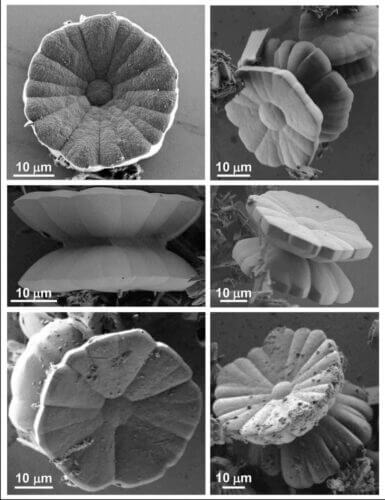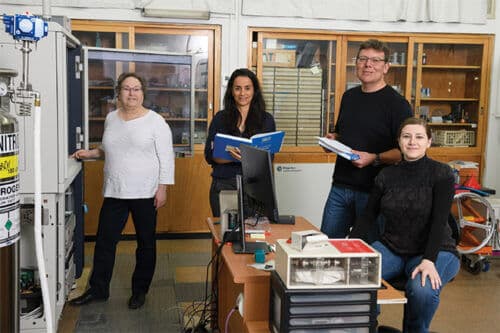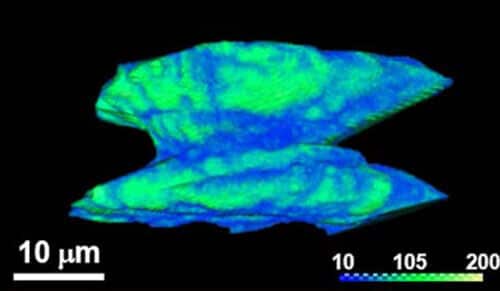How can you grow crystals with uniform dimensions and shape - and how can you combine chiral properties in them?

What would an architect do if he were tasked with designing a Colosseum-like structure - full of arches, vaults and reliefs - while maintaining the following requirements: using only one type of bricks and placing them one on top of the other precisely, in a symmetrical arrangement, without any deviations? He would surely say that this is an impossible task, since these requirements would allow, at most, to build a continuous multi-story tower divided into only one space for its entire height. Nature has similar rules for creating single-crystals - which are among the most ordered structures in our world, in which the "bricks" (atoms or molecules) are stacked on top of each other in a symmetrical way, creating a continuous structure, with sharp edges and no internal divisions.
The rules for creating molecular single crystals are indeed strict, so it is difficult to imagine the possibility of deviating from them. Nevertheless, Weizmann Institute of Science scientists managed to create paradoxical structures: continuous single crystals with a complex asymmetrical shape, internal division into spaces and rounded lines. The question of the crystal structure is of course not only aesthetic - in crystal engineering as in architecture, the structure is of crucial importance in determining the properties of the material. Therefore, the findings of the researchers recently reported in the scientific journal Nature Communications actually reveal a new type of organometallic materials endowed with unique properties.
left-right-left
In the field of crystal engineering, many questions still remain open, including how can crystals with uniform dimensions and shape be grown - and how can chiral properties be integrated into them and even control these properties? Chiral molecules are identical molecules in their composition, which are a mirror image of each other. Similar to palms of hands, also in chiral molecules it is customary to speak of "left" and "right" chirality, and naturally it is impossible to place them one on top of the other in full alignment. Chiral molecules can form helical structures whose direction of rotation - clockwise or counterclockwise - is determined according to whether they are "right-handed" or "left-handed". Chirality exists in nature at every scale - starting with the microscopic DNA coil, through a macroscopic structure such as the snail's shell, and ending with galaxies.
In recent years, the Italian post-doctoral researcher, Dr. Maria Chiara Di Gregorio, senior faculty scientist Dr. Michal Lahav and Prof. Milko van der Baum from the Department of Organic Chemistry, developed a method to create single crystals with a very complex appearance. Not only that the crystals they created have a "yo-yo" shape, each of its halves has a different direction of rotation, but also each of the halves resembles a kind of chiral "flower" with many "petals". In order to understand how such a structure was formed from symmetric and chiral molecules, the scientists used different methods to examine the crystals at three levels: the morphological (external) level, the molecular level and an intermediate level - the electron density distribution.

First, with the help of a scanning electron microscope, they were able to identify at the morphological level four stages of crystallization: a chemical reaction between organic molecules and between metal atoms in a solution at a given temperature first yields cylindrical structures that lack chiral form; These are the "buds" that in the next steps will become chiral objects. Later, the rolls develop into two curved hexagons, after which petals emerge that are asymmetrically arranged on the surface in a flower-like structure. In the last stage, the crystals develop into a structure with a well-defined yo-yo-like shape.
The scientists did not stop at the outer level. They realized that investigating the structure with the help of micro-CT imaging - an unconventional method in XNUMXD analysis of organometallic crystals - may reveal hidden details at the intermediate level, which includes the electron density distribution. Indeed, these measurements revealed a single and continuous spiral motif, which extends over the entire structure, from base to base, thus supporting the idea that it is a chiral single crystal. These findings were also investigated at the molecular level using X-ray scattering; These measurements, performed by Dr. Linda Shimon from the Department of Chemical Research Infrastructures, also showed that the yo-yo structure is actually a single-crystal structure. These measurements also revealed chiral channels laid out as spiral steps along the entire structure, from top to bottom.

"These are exciting results - we managed to create a completely unique type of buildings," says Prof. van der Baum. "As chemists, this gives us deep insights into the formation of crystals, and how we can create fascinating materials with new properties." The scientists hope that their new type of crystal will find future use in applications such as green energy storage, absorbing carbon dioxide from the atmosphere or increasing the rate and selectivity of chemical reactions in industry.
Dr. Vlad Brumfeld and Dr. Luther Hoben from the Department of Chemical Research Infrastructures also participated in the study.
Out of 1,000,000 existing molecular crystals, only 7 crystals belong to the same spatial symmetry group of the yo-yo crystals.
More of the topic in Hayadan:
